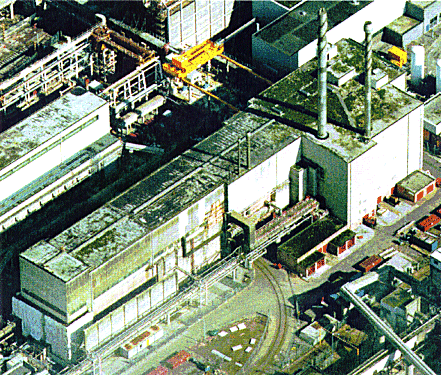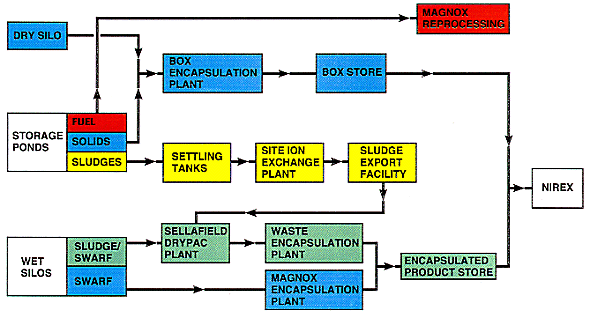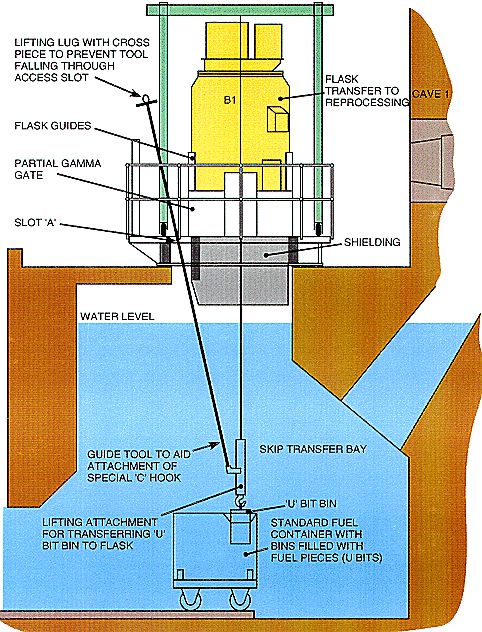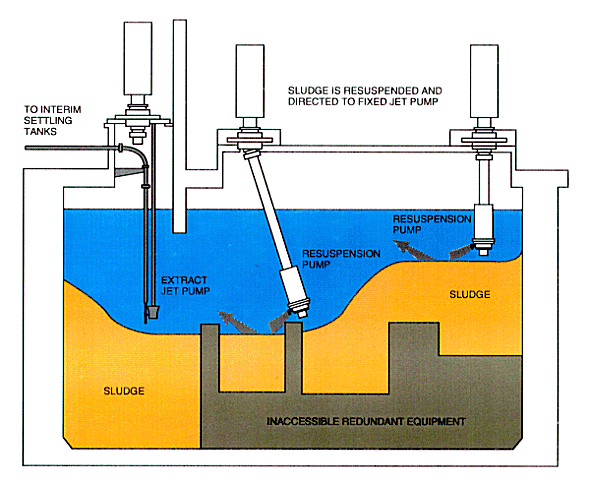
Fig. 1. MAGNOX fuel storage and
decanning plant.
E. J. Williamson, D. H. Norton, A. F. Hurley, N. P. Houghton
Waste Management and Decommissioning
British Nuclear Fuels plc
ABSTRACT
British Nuclear Fuels plc (BNFL) owns and operates the United Kingdom's nuclear fuel reprocessing facility at Sellafield on the West Coast of England. Several generations of plants have been operated to reprocess irradiated nuclear fuel over a period of time in excess of 40 years. Many of these early plants have now been taken out of service, but retain nuclear fuel and material inventory.
This paper describes how BNFL developed and implemented strategies to clean out residual radioactive wastes from these obsolete plants in preparation for final decommissioning. The Magnox Fuel Storage and Decanning Plant is used as an example of how BNFL has applied an integrated strategy to clean-up business. The objective is to carry out this work in a safe and economic manner within the overall site waste management program.
BACKGROUND
The reprocessing of irradiated Magnox Fuel (solid natural uranium clad in a magnesium alloy can) involves storage underwater, removal of the can, dissolution in acid and chemical separation.
The Original Magnox Fuel Storage and Decanning Plant (Fig. 1) operated for 26 years and processed over 25000 tonnes of fuel. It was taken off-line in 1986 when new facilities were commissioned. During operation solid radioactive waste was stored locally in concrete silos (Fig. 2) whilst in the plant there accumulated residual and damaged fuel (1000te), sludges (2000m) and debris (500m). In 1993 the silos contained 8000m of miscellaneous waste stored underwater. Working conditions within the plants were difficult due to high levels of radiation and contamination.

Fig. 1. MAGNOX fuel storage and
decanning plant.
The overall radioactive inventory amounted to approximately 2x106 TBq.
BNFL has been implementing, over several years, a fully integrated waste management policy. All present and future waste forms are identified and waste treatment and disposal routes are agreed with Customers and Regulators. Several treatment plants have now been built and others are being planned.

Fig. 2. Concrete silos.
CLEAN OUT OBJECTIVES
Safety, Regulatory, technical and economic considerations are the main drivers for carrying out clean out programs. Although wastes have been stored safely in bulk for many years, a fundamental change took place from 1980 onwards. BNFL developed a waste management policy to remove, from obsolete plants, all mobile radioactive waste in order that it can be processed into a non-hazardous form suitable for long term storage.
At present, obsolete plants demand a high level of care and maintenance at a high financial and manpower cost. The objective is to achieve low surveillance and maintenance cost status as soon as possible, for example, when all mobile wastes are either removed or immobilized. Waste treatment plants are available now or will be in the near future, to process the expected volume of waste retrieved over a programmed economic lifetime.
DEVELOPMENT OF CLEAN OUT STRATEGIES
Technical
In order to ensure a safe plant is available to support clean out and decommissioning activities over 20-30 years, a program of surveys, assessments and plant upgrades is being carried out, including dose reduction projects. These include new ventilation systems, new cranes (remotely controlled) and other plant improvements.
An inventory of all radioactive wastes was compiled detailing location, quantities and characteristics and agreement made on wastes routes and treatment.
New equipment has been developed, procured and installed to retrieve materials in a safe and economic manner.
Safety
As part of the Nuclear Site Licence Conditions changes to plant, structure and processes attract detailed safety assessments and amendments to existing fully developed Safety Cases (fdSC's).
As projects are identified in the clean out strategy, they are subjected to rigorous ALARP (As Low As Reasonably Practical) assessments to ensure minimum radiation dose to personnel. To support the technical strategy, a program of safety case documentation submissions and presentation to the Regulators is being carried out in order to obtain approval.
Financial
There is a clear requirement to maintain a tight control of costs in such a technically challenging project. To achieve this lifetime programs and costs have been developed based on the technical strategy. Regular discussions are held with customers so that early agreement and sanction can be obtained.
A key feature of this financial control has been the use of financial risk assessment, quantification and management.
Human Resources
The organization required to carry out clean up projects has been reviewed on a regular basis and progressively changed from production plant mode (standard repetitive tasks) to a project organization. This has entailed developing a work breakdown structure showing specific tasks and work areas. The introduction of new techniques and equipment has required a changing skill base with varying training requirements.
Intermediate Level Waste (ILW) Strategy
BNFL has developed over recent years a total site waste management strategy. A range of treatment plants have been built over the last 10 years and more are planned to handle and process all waste arisings at Sellafield into a form acceptable for either long term storage or discharge off-site. These treatment processes include encapsulation, vitrification ion exchange and compaction.
The clean out the Magnox Ponds and Decanning plant and storage silos integrates fully with the site waste strategy (Fig. 3).

Fig. 3. ILW routing diagram.
DEVELOPMENT OF TECHNOLOGIES
The retrieval and treatment of radioactive wastes requires a whole range of new technology to be developed. Techniques and processes have been developed and implemented in the following areas:
Extensive development work is ongoing to achieve acceptable cost effective waste forms for long term disposal and storage.
MANAGEMENT OF CHANGE
The Sellafield Site is going through a period of significant change to meet a changing safety, commercial and economic environment. The workforce is involved at all levels in developing new methods of working in order that any changes can be effectively introduced. These include:
Safety is seen as a major consideration in designing new equipment and processes. The latest team building and employee development techniques have been used with success together with strategic management initiatives.
ACHIEVEMENTS TO DATE
Substantial progress has been made towards meeting the overall clean out objectives.
Plant Improvements
The plant has been upgraded and improved by installing new facilities which include:
Clean Out of Radioactive Inventory
The bulk of the radioactive waste (fuel, sludge, ILW) has been accumulated in the storage ponds, wet bays (concrete tanks) and silos.
Several techniques and processes have been developed and successfully used to retrieve and separate the wastes for transfer to treatment plants and ultimate storage. These include:
Pond

Fig. 4. Fuel flasking station.
Wet Bays

Fig. 5. Sludge mobilization and
transfer equipment.
Silos
BNFL is continuing to build on the success of the clean up program and further work is ongoing to design and develop new equipment and additional plant upgrades including:
Retrievals projects have been implemented and have successfully reduced the overall radioactive inventory from 2 x 106 TBq to less than 1.5 x 106 TBq.
To date material retrieved and sent for treatment include:
CONCLUSION
The strategy for Post Operational Clean Out has been developed in a structured manner reflecting the requirements and constraints imposed by safety, technical and commercial considerations.
Significant progress to date has been achieved and lifetime cost and time targets will be met. In addition, radiation dose to personnel has been kept within strict limits and to a minimum during the early stages of clean up of a plant with some of the most difficult radiological conditions in the United Kingdom. Radiation doses have been significantly reduced since the start of the clean up program.
The major success factors included:
The work achieved so far has demonstrated that BNFL has the ability to undertake difficult and complex Post Operational Clean Out and Decommissioning tasks safely whilst meeting the commercial targets set by the Company and external customers.